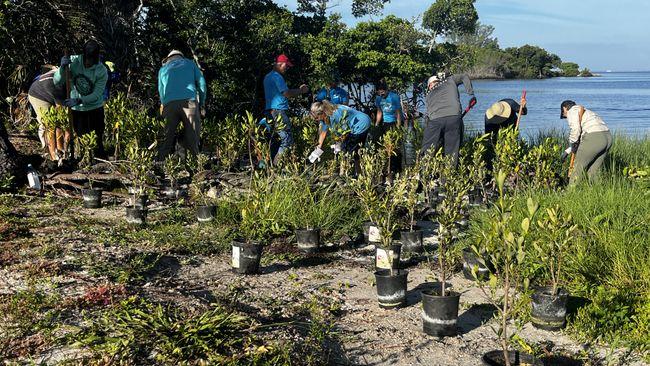A New Meaning to Restoration: Duke Energy, Tampa Electric Come Together With State, Local Agencies to Plant Nearly 700 Mangroves at Two Shorelines in Hillsborough and Pinellas Counties
Published 09-11-24
Submitted by Duke Energy

ST. PETERSBURG and TAMPA, Fla., September 11, 2024 /CSRwire/ – While restoration is a critical part of Duke Energy Florida’s and Tampa Electric’s everyday work and hurricane response plans, this is the first time the two local utilities have combined resources to protect Tampa Bay’s ecosystems and increase environmental resilience within the region.
Today, more than 40 volunteers, employees and environmental experts from Duke Energy Florida, Tampa Electric, Coastal Conservation Association (CCA) Florida, Hillsborough County’s Conservation and Land Management and Pinellas County’s Environmental Management Division, led a unique restoration project by simultaneously planting nearly 700 red and black mangroves at two locations impacted by tidal influence.
“Teaming up with our neighboring utilities, governmental leaders and key community organizations to prepare, protect and power our communities is not something new for our company and industry,” said Melissa Seixas, Duke Energy Florida state president. “As we’ve learned from decades of storm response and service, collaboration is essential to addressing our communities’ most pressing needs. Today’s event is no different. We thank Tampa Electric, CCA Florida, Hillsborough and Pinellas counties, among the many others, who are dedicated to keeping our communities safe, resilient and thriving.”
The two locations, EG Simmons Regional Park and Keystone/Carlton Road in Northern Pinellas County, were selected based on need, environmental factors and consultation with Hillsborough County’s Conservation and Land Management and Pinellas County’s Environmental Management Division.
“This project is a win for the shoreline, a win for our partners, and it reflects our continued commitment to environmental stewardship,” said Archie Collins, president and chief executive officer of Tampa Electric. “We are delighted to collaborate with like-minded neighbors – including Duke Energy Florida – to complete this important coastal resilience project.”
Florida's mangrove ecosystems serve a vital role in the overall health of the state’s coastal estuaries. Mangroves reduce coastal erosion caused by storm surges and improve water quality by absorbing excess nutrients like nitrogen and phosphorus. Mangrove soils and roots also sequester carbon dioxide while providing habitat and refuge to a wide variety of fish and wildlife.
The mangroves are grown and donated by CCA Florida and the Duke Energy Crystal River Mariculture Center, a company-owned-and-operated environmental restoration and conservation center dedicated to rebuilding and maintaining Florida’s fish populations and habitats.
More than 30 years ago, the Duke Energy Crystal River Mariculture Center started as an environmental compliance requirement to operate nearby power plants and has since grown into one of Florida’s most successful fish hatcheries and conservation allies.
Instead of shutting down the operation when the power plants closed and the environmental requirement was no longer necessary, Eric Latimer, Duke Energy Florida’s manager of the Mariculture Center, found ways to work with nonprofits, universities and state agencies, like CCA Florida, among others, to rebuild and maintain Florida’s fish populations and habitats that were being impacted by declining water quality and disasters such as red tide and hurricanes.
To date, the Mariculture Center, with help from CCA Florida, has released nearly 5 million fish and crustaceans along Florida’s coasts and has donated approximately $200,000 worth of submerged aquatic vegetation for habitat restoration projects in lakes, springs and shorelines across the state.
For more information about the Duke Energy Crystal River Mariculture Center, click here.
Duke Energy Florida
Duke Energy Florida, a subsidiary of Duke Energy, owns 12,300 megawatts of energy capacity, supplying electricity to 2 million residential, commercial and industrial customers across a 13,000-square-mile service area in Florida.
Tampa Electric
Tampa Electric, one of Florida’s largest investor-owned electric utilities, serves more than 840,000 customers in West Central Florida. Tampa Electric is a subsidiary of Emera Inc., a geographically diverse energy and services company headquartered in Halifax, Nova Scotia, Canada.
CCA Florida
The Coastal Conservation Association (CCA) was founded in 1977 after drastic commercial overfishing along the Texas coast decimated redfish and speckled trout populations. One of 19 state chapters, CCA Florida became the fifth state chapter in 1985. A 501(c)3 non-profit, the purpose of CCA is to advise and educate the public on conservation of marine resources. Through habitat restoration projects, water quality initiatives and fisheries advocacy, CCA Florida works with its over 18,000 members including recreational anglers and outdoor enthusiasts to conserve and enhance marine resources and coastal environments. Join the conversation on Facebook or learn more at ccaflorida.org.
Duke Energy Media Contact: Audrey Stasko
Media line: 800.559.3853
Twitter: @DE_AudreyS
Tampa Electric Media Contact: Cherie Jacobs
Cell: 813.334.7779
Email: CLJacobs@TECOEnergy.com

Duke Energy
Duke Energy
Duke Energy (NYSE: DUK), a Fortune 150 company headquartered in Charlotte, N.C., is one of America’s largest energy holding companies. The company’s electric utilities serve 8.4 million customers in North Carolina, South Carolina, Florida, Indiana, Ohio and Kentucky, and collectively own 54,800 megawatts of energy capacity. Its natural gas utilities serve 1.7 million customers in North Carolina, South Carolina, Tennessee, Ohio and Kentucky.
Duke Energy is executing an ambitious energy transition, keeping customer reliability and value at the forefront as it builds a smarter energy future. The company is investing in major electric grid upgrades and cleaner generation, including natural gas, nuclear, renewables and energy storage.
More information is available at duke-energy.com and the Duke Energy News Center. Follow Duke Energy on X, LinkedIn, Instagram and Facebook, and visit illumination for stories about the people and innovations powering our energy transition.
More from Duke Energy

